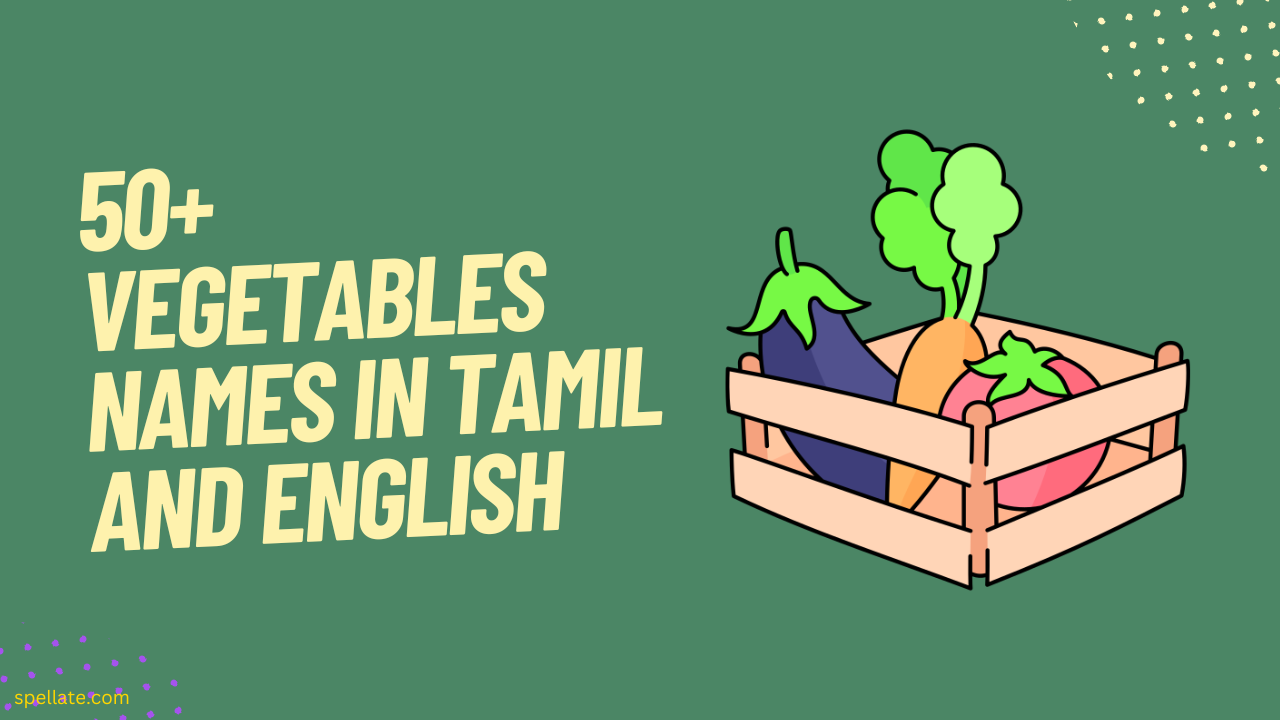Vegetables are an essential part of our daily diet, providing us with vital nutrients and contributing to our overall well-being. Whether you’re a food enthusiast, a culinary artist, or simply someone looking to expand their knowledge, knowing the vegetables names in Tamil and English can be fascinating. In this article, we delve into the world of vegetables names in Tamil and English.
From the vibrant greens of spinach and kale to the humble root vegetables like potatoes and carrots, join us on this linguistic journey as we uncover the diverse range of vegetable names in these two languages. So grab your chopping board and prepare yourself for a tantalizing blend of flavors and linguistic discoveries!
- Popular Vegetables names in Tamil and English
- 1. Potato (உருளைக்கிழங்கு – Urulaikilangu):
- 2. Tomato (தக்காளி – Thakkali):
- 3. Onion (வெங்காயம் – Vengayam):
- 4. Carrot (கேரட் – Kerat):
- 5. Spinach (பசலைக் கீரை – Pasalai Keerai):
- 6. Cauliflower (காலிபிளவர் – Kaalipilavaru):
- 7. Cabbage (முட்டாளி கோசு – Muttalai Kosu):
- 8. Brinjal/Eggplant (கத்திரிக்காய் – Kathirikai):
- 9. Bell Pepper (குடைமிளகாய் – Kudaimilagai):
- 10. Pumpkin (பரங்கிக்காய் – Parangikkai):
- 11. Radish (முள்ளங்கி – Mullangi):
- 12. Peas (பட்டாணி – Pattani):
- 13. Beetroot (பீட்ரூட் – Beetroot):
- 14. Lady’s Finger/Okra (வெண்டைக்காய் – Vendaikkai):
- List of 50 Vegetables names in Tamil and English
Popular Vegetables names in Tamil and English
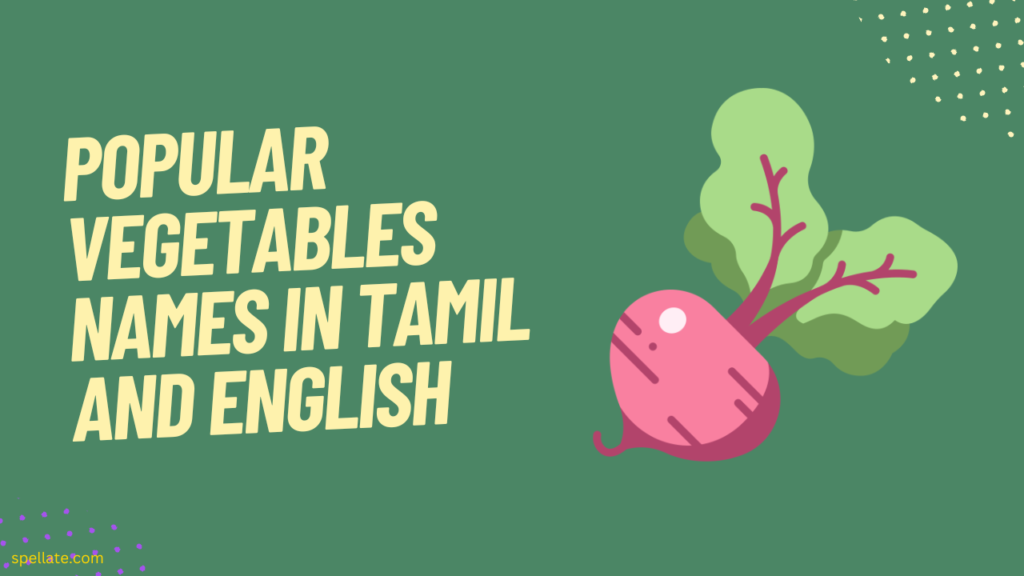
Vegetables are an essential part of our daily diet, providing us with vital nutrients and contributing to our overall health and well-being. Tamil Nadu, a vibrant state in South India known for its rich culinary traditions, has a wide range of unique vegetables that add flavor and nutrition to its traditional dishes. Here are some popular vegetables names in Tamil and English:
1. Potato (உருளைக்கிழங்கு – Urulaikilangu):
The potato is a starchy, tuberous vegetable that belongs to the Solanaceae family. It is a staple food in many cuisines around the world. In Tamil Nadu, potatoes are commonly used in various dishes, both as a main ingredient and as a complement. They are often boiled, fried, mashed, or added to curries and gravies. They are versatile and can be used to make a wide range of dishes, from simple potato poriyal (stir-fry) to complex biryanis and curries.
2. Tomato (தக்காளி – Thakkali):
The tomato is a red or yellowish fruit commonly used as a vegetable in cooking. It’s a rich source of vitamins, minerals, and antioxidants. In Tamil Nadu, tomatoes are integral to many dishes, providing both flavor and color. They are used in gravies, chutneys, salads, and sauces. Tomato-onion base forms the foundation for many South Indian curries and gravies. Additionally, tomato-based soups and rasam, a traditional South Indian soup, are popular dishes that showcase the tomato’s tangy and savory taste.
3. Onion (வெங்காயம் – Vengayam):
Onions are a fundamental ingredient in many cuisines due to their strong flavor and aroma. They belong to the Allium family and come in various types such as red, white, and yellow. In Tamil Nadu, onions are used in a variety of dishes, providing both taste and texture. They are often sautéed or caramelized to add depth to curries, chutneys, and rice dishes. Onions are also a key component of sambar, a popular South Indian lentil-based stew, and many other traditional recipes.
4. Carrot (கேரட் – Kerat):
Carrots are vibrant orange root vegetables that are rich in vitamins, minerals, and dietary fiber. They are commonly enjoyed raw as a crunchy snack, but they are also used in cooking to add color, flavor, and nutrition to dishes. In Tamil cuisine, carrots are often used in stir-fries, curries, and rice-based dishes. Carrot poriyal, a South Indian stir-fry, is a popular preparation where grated or chopped carrots are sautéed with spices, curry leaves, and grated coconut.
5. Spinach (பசலைக் கீரை – Pasalai Keerai):
Spinach is a leafy green vegetable that is known for its nutritional value, particularly its iron and calcium content. It is used in a wide range of cuisines and dishes. In Tamil Nadu, spinach (pasalai keerai) is often used to make dishes like keerai masiyal, where the leaves are cooked, mashed, and flavored with spices and sometimes lentils. Spinach is also used in soups, curries, and as a filling for dosas (savory pancakes).
6. Cauliflower (காலிபிளவர் – Kaalipilavaru):
Cauliflower is a cruciferous vegetable with a dense, flower-like head that is composed of tightly packed florets. It is a versatile vegetable that can be used in both raw and cooked forms. In Tamil cuisine, cauliflower is often used to make dishes like cauliflower poriyal (stir-fry) and cauliflower curry. Additionally, it can be coated in spiced chickpea flour batter and deep-fried to make a popular snack known as “gobi 65.” Cauliflower is also used to create a low-carb alternative to rice by processing it into small, rice-like pieces.
7. Cabbage (முட்டாளி கோசு – Muttalai Kosu):
Cabbage is a leafy green or purple vegetable that belongs to the cruciferous family. It is known for its crunchy texture and is commonly used in salads, coleslaws, and various cooked dishes. In Tamil Nadu, cabbage is often used to make cabbage poriyal, a stir-fry where shredded cabbage is sautéed with spices and grated coconut. It’s also used in kootu, a dish made with vegetables and lentils cooked with coconut and spices.
8. Brinjal/Eggplant (கத்திரிக்காய் – Kathirikai):
Brinjal, also known as eggplant or aubergine, is a purple or green vegetable with smooth skin and creamy flesh. It’s used in various cuisines to add a rich, meaty texture to dishes. In Tamil Nadu, brinjal is a key ingredient in dishes like kathirikai sambar (lentil stew with brinjal) and kathirikai poriyal (brinjal stir-fry). It can also be used to make chutneys and curries.
9. Bell Pepper (குடைமிளகாய் – Kudaimilagai):
Bell peppers, also known as capsicums, come in various colors including green, red, yellow, and orange. They are sweet and crunchy, adding a burst of color and flavor to dishes. In Tamil Nadu, bell peppers are used in curries, stir-fries, and salads. They are often stuffed with a mixture of spices and other ingredients to make a dish called “bharwan shimla mirch.”
10. Pumpkin (பரங்கிக்காய் – Parangikkai):
Pumpkin is a versatile and nutritious vegetable that comes in various shapes and sizes. It has a mild, slightly sweet flavor and is often used in both savory and sweet dishes. In Tamil cuisine, pumpkin is used to make dishes like parangikkai sambar, where it’s cooked with lentils and spices, and parangikkai poriyal, a stir-fry with grated coconut and spices. Pumpkin is also used in traditional sweets like pumpkin halwa.
11. Radish (முள்ளங்கி – Mullangi):
Radish is a root vegetable with a crisp texture and a slightly peppery flavor. It’s commonly used in salads, pickles, and cooked dishes. In Tamil Nadu, radish is often used to make mullangi sambar, a lentil-based stew with radish, and mullangi poriyal, a stir-fry dish. Radish is also sometimes grated and added to yogurt-based preparations like raita.
12. Peas (பட்டாணி – Pattani):
Peas are small, round, and green seeds that are commonly used as a vegetable in various dishes. They are a good source of protein, fiber, and essential nutrients. In Tamil cuisine, peas are used in dishes like pattani masala, a spiced pea curry, and pattani paruppu usili, where the peas are combined with a ground lentil mixture. They are also added to biryanis, pulao, and other rice-based dishes.
13. Beetroot (பீட்ரூட் – Beetroot):
Beetroot is a root vegetable known for its deep red color and sweet taste. It’s rich in antioxidants and nutrients. In Tamil Nadu, beetroot is used to make dishes like beetroot poriyal, where it’s grated and stir-fried with spices and coconut. It’s also used in salads, and its vibrant color often adds an appealing element to various preparations.
You May Also Like
14. Lady’s Finger/Okra (வெண்டைக்காய் – Vendaikkai):
Lady’s finger, also known as okra, is a green, elongated vegetable with a unique texture. It’s often used in South Indian cuisine to add a slimy yet delicious element to dishes. In Tamil Nadu, vendaikkai is used to make dishes like vendakkai poriyal, where the okra is sliced and sautéed with spices, and vendakkai sambar, a lentil-based stew. Okra is also used in popular dishes like gumbo and is sometimes battered and deep-fried.
List of 50 Vegetables names in Tamil and English
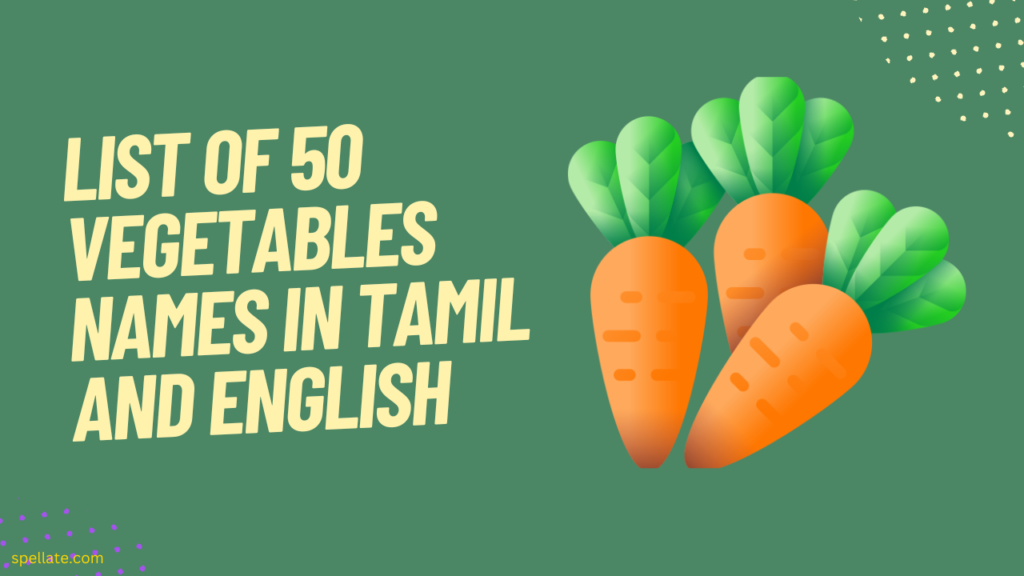
Tamil cuisine is known for its vibrant flavors and diverse array of ingredients, especially vegetables. Vegetables play a crucial role in Tamil cuisine, adding color, flavor, and nutrition to every dish. Whether you’re a food enthusiast looking to expand your culinary horizons or someone trying to learn the vegetables names in Tamil and English, this list of 50 vegetables will be an invaluable resource.
| No. | Vegetables Name In Tamil (தமிழ்) | Vegetables Name In English |
| 1 | உருளைக்கிழங்கு (Urulaikilangu) | Potato |
| 2 | தக்காளி (Thakkali) | Tomato |
| 3 | வெங்காயம் (Vengayam) | Onion |
| 4 | கேரட் (Kerat) | Carrot |
| 5 | பசலைக் கீரை (Pasalai Keerai) | Spinach |
| 6 | காலிபிளவர் (Kaalipilavaru) | Cauliflower |
| 7 | முட்டாளி கோசு (Muttalai Kosu) | Cabbage |
| 8 | கத்திரிக்காய் (Kathirikai) | Brinjal/Eggplant |
| 9 | குடைமிளகாய் (Kudaimilagai) | Bell Pepper |
| 10 | பரங்கிக்காய் (Parangikkai) | Pumpkin |
| 11 | முள்ளங்கி (Mullangi) | Radish |
| 12 | பீன்ஸ் (Beans) | Beans |
| 13 | பட்டாணி (Pattani) | Peas |
| 14 | பீட்ரூட் (Beetroot) | Beetroot |
| 15 | வெண்டைக்காய் (Vendaikkai) | Lady’s Finger/Okra |
| 16 | சுரைக்காய் (Surakkai) | Bottle Gourd |
| 17 | பூண்டு (Poondu) | Garlic |
| 18 | பூன்னைக்கிழங்கு (Poonnaikilangu) | Taro Root |
| 19 | வாழைக்காய் (Vazhaikkai) | Raw Banana/Plantain |
| 20 | ஆரைக்கிழங்கு (Araikilangu) | Yam |
| 21 | பச்சை மிளகாய் (Pachai Milagai) | Green Chili |
| 22 | பெரிய மிளகாய் (Periya Milagai) | Red Chili |
| 23 | அவரைக்காய் (Avarakkai) | Broad Beans |
| 24 | கொத்தவரை (Kothavarai) | Cluster Beans |
| 25 | பீசணக்காய் (Peasankai) | Ridge Gourd |
| 26 | சௌரஷ்ட்ர வட்டக்காய் (Saurashtra Vattakkai) | Ivy Gourd |
| 27 | புடலங்காய் (Podalangai) | Snake Gourd |
| 28 | பெரிய பீர்க்கங்காய் (Periya Peerkangai) | Ash Gourd |
| 29 | குடலை பருப்பு (Kadalai Paruppu) | Chickpea/Garbanzo Beans |
| 30 | பாக்கோடா (Paakkoda) | Drumstick |
| 31 | குதிரைவள்ளி காய் (Kuthiraivali Kaai) | Amaranth Leaves |
| 32 | கீரை (Keerai) | Greens/Spinach |
| 33 | முள்ளுக்கிழங்கு (Mullukilangu) | Arbi/Colocasia |
| 34 | சீரகம் (Seeragam) | Cumin |
| 35 | கடுகு (Kadugu) | Mustard |
| 36 | உலுந்து (Ulundhu) | Black Gram/Urad Dal |
| 37 | பாசி பருப்பு (Paasi Paruppu) | Moong Dal |
| 38 | துவரம் பருப்பு (Thuvaram Paruppu) | Toor Dal |
| 39 | கொந்தக்காய் (Kondakka) | Tindora/Ivy Gourd |
| 40 | புதினா (Pudhina) | Mint |
| 41 | முருங்கக்கை (Murungakkai) | Drumstick |
| 42 | அவலம் (Aval) | Poha/Flattened Rice |
| 43 | சிவப்பு கடலை (Sivappu Kadalai) | Red Gram/Red Lentil |
| 44 | பெரிய கடலை (Periya Kadalai) | Peanut |
| 45 | முள்ளு (Mullu) | Rosemary |
| 46 | முள்ளிக்கீரை (Mullikkeerai) | Amaranth |
| 47 | புதினாக்கீரை (Pudhinakeerai) | Mint Leaves |
| 48 | தக்காளி கீரை (Thakkali Keerai) | Tomato Greens |
| 49 | புதினா கொத்தமல்லி (Pudhina Kothamalli) | Mint and Coriander Leaves |
| 50 | சிருந்திக்காய் (Siruthaikkai) | Turkey Berry |
| 51 | கமரங்காய் (Kamara Kizhangu) | Sweet Potato |
| 52 | புதினாவாய் (Pudhina Vayi) | Mint Varieties |
Tips for Pronouncing Vegetable Names Correctly in Tamil
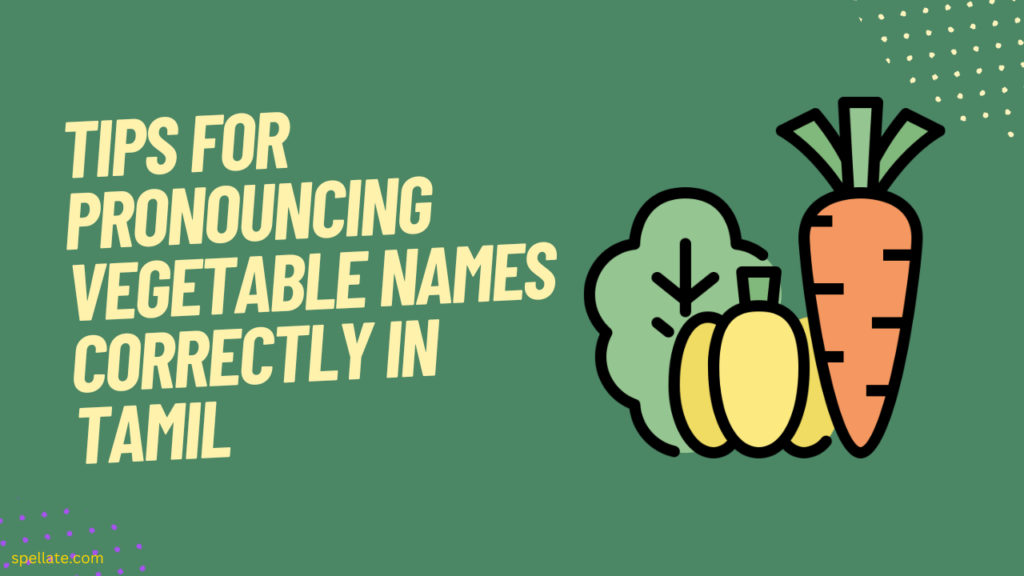
One of the trickiest aspects of learning Tamil is pronouncing vegetables names in Tamil and English correctly. With its unique and melodic sounds, the Tamil language has a plethora of vowel and consonant combinations that may seem daunting at first. However, with a little practice and guidance, you can easily master the correct pronunciation of vegetable names in Tamil.
When it comes to pronouncing vegetable names in Tamil, one key aspect to keep in mind is emphasis on certain syllables. Unlike English or other languages where stress falls on different parts of a word, Tamil usually emphasizes the second syllable. For example, when saying vendakkai (okra), make sure to emphasize the da sound rather than the ven sound. Paying attention to this subtle aspect will greatly improve your ability to pronounce various vegetable names accurately and fluently.
Another helpful tip for perfecting your pronunciation of Tamil vegetable names is studying the phonetic sounds used in the language itself. By familiarizing yourself with these phonetic sounds such as zh, which doesn’t exist in many other languages, you will be better prepared to tackle challenging words like kathrikai (brinjal or eggplant). Listening to native speakers or utilizing language resources online can also provide valuable examples for developing an ear for these distinct sounds. Remember, practice makes perfect!
Resources for learning vegetables names in Tamil and English
If you’re looking to learn vegetable names in Tamil and English, there are several resources you can use:
Online Language Learning Platforms: Websites and apps like Duolingo, Memrise, and Babbel often include vocabulary lists for different languages, including Tamil and English. These platforms offer interactive lessons and quizzes to help you practice and remember the names of vegetables in Tamil and English.
Language Learning Apps: Apps specifically designed for learning languages can be very helpful. An example is “Learn Tamil Quickly” for Android devices. These apps often provide flashcards, quizzes, and pronunciation guides.
Cookbooks and Recipe Websites: Cookbooks and recipe websites that focus on Tamil cuisine often list the vegetables names in Tamil and English. They can provide context and examples of how these vegetables are used in cooking.
Visual Dictionaries and Picture Books: Visual dictionaries and picture books are great for associating the names of vegetables with their images. “Tamil-English Bilingual Visual Dictionary” by DK and “My First Book of Tamil Words” by Katy R. Kudela are examples you might find helpful.
Online Translators and Dictionaries: Online translation tools and dictionaries like Google Translate or WordReference can help you quickly find the translations of specific vegetables names in Tamil and English.
YouTube Tutorials: YouTube hosts various tutorials that focus on language learning. You can find videos that specifically cover Tamil and English vegetable names pronunciation and usage.
Local Markets and Grocery Stores: Visiting local markets or grocery stores that carry a variety of vegetables can be a practical way to learn the names of vegetables in Tamil and English. You can observe the items and their labels.
Language Learning Communities: Join online language learning communities, forums, or social media groups dedicated to Tamil learning. Members often share resources, tips, and vocabulary lists.
Advantages of knowing vegetable names in both languages
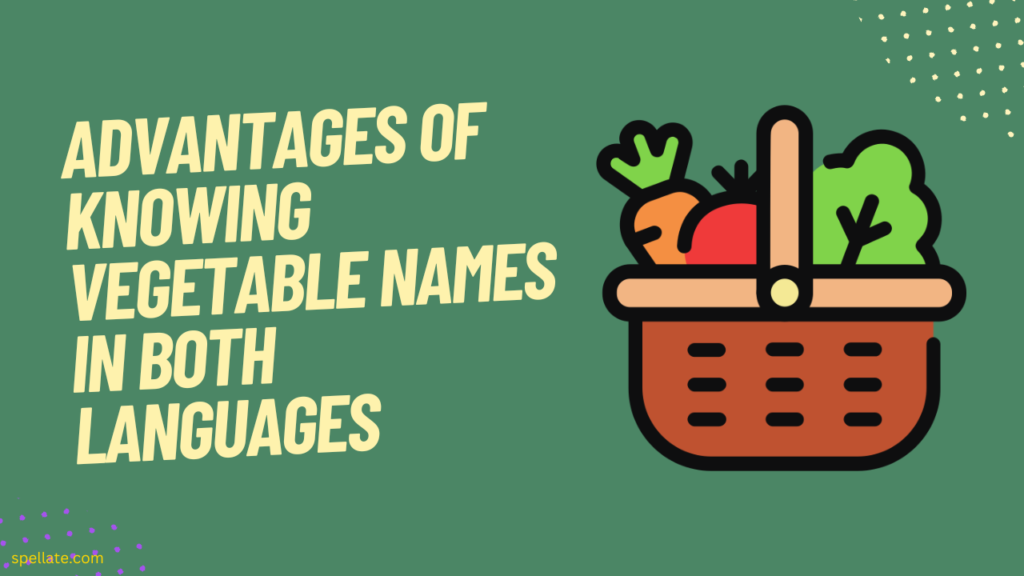
Knowing vegetables names in Tamil and English can be extremely advantageous for various reasons. Firstly, it helps in bridging the language barrier between different cultures. In today’s globalized world, having knowledge of multiple languages enables better communication and understanding. Knowing vegetable names in Tamil and English allows individuals to easily communicate about different vegetables with people from diverse backgrounds.
Secondly, being familiar with vegetables names in Tamil and English can enhance one’s culinary skills. It opens up a whole new world of recipes and cooking techniques that may not have been explored before. By knowing vegetable names in Tamil and English, one can effortlessly find different recipes online or understand the ingredients used in traditional Tamil dishes.
Lastly, having this knowledge also facilitates healthy eating habits. When grocery shopping or dining out, knowing vegetables names in Tamil and English ensures that there is no confusion about what is being purchased or consumed. This empowers individuals to make informed choices while selecting vegetables and helps them to easily identify the nutritional value of each item.
Overall, being able to recognize vegetable names in English and Tamil has numerous advantages. From fostering cross-cultural understanding to expanding culinary horizons and promoting healthy eating habits, it unlocks several opportunities for personal growth and development. So why not take the time to learn these names? Your adventures in food exploration await!
Final Thoughts
In conclusion, knowing the names of vegetables in Tamil and English can be useful for various purposes. It helps individuals communicate effectively while shopping for groceries, cooking, or discussing dietary preferences. Additionally, it promotes cultural understanding and appreciation by bridging the language barrier. Learning these names also encourages a healthy lifestyle as it enables people to make informed choices about their food consumption.
So, let’s continue to explore the rich world of vegetables through their names in Tamil and English and embrace the benefits that come with this knowledge. Start incorporating these terms into your everyday vocabulary and enjoy the vibrant flavors and nutrition that vegetables have to offer!
FAQs
How do you say cauliflower in English and Tamil?
The English term cauliflower remains unchanged, while it’s called vallarai in Tamil.
Can you provide examples of leafy greens in both Tamil and English?
Certainly! Some examples of leafy greens in Tamil and English are:
- சிருந்தை (Sirundai) – Amaranth Leaves
- அகில் (Akkil) – Mustard Greens/Indian Greens
- முருுങ്ഗാക്കൊഴി ഇല( Murungakkochi Ela ) Drumstick Leaves.
Are there any specific vegetables that are commonly used in Tamil cuisine?
Yes, Tamil cuisine incorporates a variety of vegetables. Some commonly used vegetables are பீர்க்கங்காய் (Peerkkankai) – Ridge Gourd, வெள்ளிரித்தண்டு (Vellari Thandu) – Cucumber, and சுரைக்காய் (Surakkai) – Bottle Gourd.
Can you provide the English translation for புடலங்கை (Puttalangai)?
The English translation for புடலங்கை (Puttalangai) is Snake Gourd.
